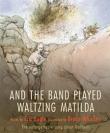AustLit
Latest Issues
AbstractHistoryArchive Description
'But the band played 'Waltzing Matilda' when we stopped to bury our slain. We buried ours, and the Turks buried theirs; then we started all over again.
'Eric Bogle's famous and familiar Australian song about the Battle of Gallipoli explores the futility of war with haunting power. Now Bruce Whatley's evocative illustrations bring a heart-rending sense of reality to the tale.
'A timely story for every generation to share.' (Publication summary)
Publication Details of Only Known VersionEarliest 2 Known Versions of
Works about this Work
-
And the Band Played Waltzing Matilda : Australian Picture Books (1999–2016) and the First World War
2019
single work
criticism
— Appears in: Children's Literature in Education , vol. 50 no. 2 2019; (p. 91-109)'Over the past two decades children’s picture books dealing with the Australian experience during the First World War have sought to balance a number of thematic imperatives. The increasingly sentimentalised construct of the Australian soldier as a victim of trauma, the challenge of providing a moral lesson that reflects both modern ideological assumptions and the historical record, and the traditional use of Australian war literature as an exercise in nation building have all exerted an influence on the literary output of a range of authors and illustrators. The number of publications over this period is proof of the enduring fascination with war as a topic as well as the widespread acceptance that this conflict has been profoundly significant in shaping Australian public and political culture and perceptions about national character and identity (Beaumont, 1995, p. xvii). As MacCallum-Stewart (2007, p. 177) argues, authors and illustrators must therefore balance notions of ‘respect’ for a national foundation myth with a ‘pity of war’ approach that reflects modern attitudes to conflict. Whatever their ideological commitment, many authors and illustrators respond to this challenge by adopting an approach that serves to indoctrinate readers into the Anzac tradition (Anzac refers to the Australian and New Zealand Army Corps raised for war in 1914. It has become a generic term for Australian and New Zealand soldiers. The Anzac tradition established at Gallipoli, Australia’s first major military campaign, has been traditionally viewed as the nation’s founding.'
Source: Publication blurb.
-
Review : And the Band Played Waltzing Matilda
2015
single work
review
— Appears in: Good Reading , February 2015;
— Review of And the Band Played Waltzing Matilda 2015 single work picture book -
Little Diggers
2015
single work
review
— Appears in: The Weekend Australian , 25-26 April 2015; (p. 16-17)
— Review of The Last Anzac 2015 single work picture book ; Meet... The ANZACs 2014 single work information book ; And the Band Played Waltzing Matilda 2015 single work picture book ; My Gallipoli 2015 single work novel ; Digger : The Dog Who Went to War 2015 single work picture book -
Review : And the Band Played Waltzing Matilda
2015
single work
review
— Appears in: Magpies : Talking About Books for Children , March vol. 30 no. 1 2015; (p. 32)
— Review of And the Band Played Waltzing Matilda 2015 single work picture book
-
Review : And the Band Played Waltzing Matilda
2015
single work
review
— Appears in: Magpies : Talking About Books for Children , March vol. 30 no. 1 2015; (p. 32)
— Review of And the Band Played Waltzing Matilda 2015 single work picture book -
Little Diggers
2015
single work
review
— Appears in: The Weekend Australian , 25-26 April 2015; (p. 16-17)
— Review of The Last Anzac 2015 single work picture book ; Meet... The ANZACs 2014 single work information book ; And the Band Played Waltzing Matilda 2015 single work picture book ; My Gallipoli 2015 single work novel ; Digger : The Dog Who Went to War 2015 single work picture book -
Review : And the Band Played Waltzing Matilda
2015
single work
review
— Appears in: Good Reading , February 2015;
— Review of And the Band Played Waltzing Matilda 2015 single work picture book -
And the Band Played Waltzing Matilda : Australian Picture Books (1999–2016) and the First World War
2019
single work
criticism
— Appears in: Children's Literature in Education , vol. 50 no. 2 2019; (p. 91-109)'Over the past two decades children’s picture books dealing with the Australian experience during the First World War have sought to balance a number of thematic imperatives. The increasingly sentimentalised construct of the Australian soldier as a victim of trauma, the challenge of providing a moral lesson that reflects both modern ideological assumptions and the historical record, and the traditional use of Australian war literature as an exercise in nation building have all exerted an influence on the literary output of a range of authors and illustrators. The number of publications over this period is proof of the enduring fascination with war as a topic as well as the widespread acceptance that this conflict has been profoundly significant in shaping Australian public and political culture and perceptions about national character and identity (Beaumont, 1995, p. xvii). As MacCallum-Stewart (2007, p. 177) argues, authors and illustrators must therefore balance notions of ‘respect’ for a national foundation myth with a ‘pity of war’ approach that reflects modern attitudes to conflict. Whatever their ideological commitment, many authors and illustrators respond to this challenge by adopting an approach that serves to indoctrinate readers into the Anzac tradition (Anzac refers to the Australian and New Zealand Army Corps raised for war in 1914. It has become a generic term for Australian and New Zealand soldiers. The Anzac tradition established at Gallipoli, Australia’s first major military campaign, has been traditionally viewed as the nation’s founding.'
Source: Publication blurb.
Awards
- 2016 shortlisted CBCA Book of the Year Awards — Picture Book of the Year
- 2016 CBCA Book of the Year Awards — Notable Book — Picture Book
-
Gallipoli,
cTurkey,cMiddle East, Asia,





